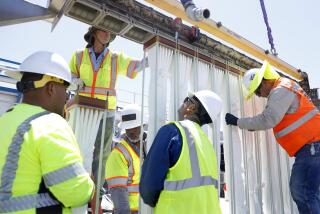CLEANUP AT CLAIROL
- Share via
If necessity is the mother of invention, expense is the mother of necessity.
At Clairol’s Camarillo plant the expense of getting rid of contaminated wash water increased sixfold when an off-site waste disposal facility stopped accepting liquids in 1985. Out of necessity Clairol invented a cheaper solution.
Clairol manufactures a fifth of its national volume of shampoos, dyes, sprays and other hair-care products in Camarillo. The blending of some 200 different formulas requires tanks, mixing equipment and more than 5,000 feet of transfer pipes, all of which must be washed between batches to avoid “cross-contamination” of products. Therein lies the waste. So much usable product was being thrown out with the bath water that Clairol began calling the rinse water “liquid gold.”
In January, 1986, Clairol initiated a “zero waste program” at Camarillo with the objective of eliminating all off-site disposal--liquid and solid--by 1991. Liquid gold was at the top of the hit list.
With employee cooperation simple changes were implemented. Wash water is now caught in receptacles instead of allowed to flow onto the floor, eliminating the need for frequent floor washings. Workers now mix formulas in shade sequence--light colors first, followed by progressively darker ones--so that tanks require less rinsing between batches. To remove product adhering to the inside of pipes, a foam ball is propelled through the lines by air, pushing the chemicals to an outlet. The pipes then require only a light rinse, and the resulting waste water is far less contaminated than it was under the old system.
The program has been so successful that Clairol now regards the Camarillo plant as the company model for waste minimization. Plastic bottles and bags, empty drums and corrugated boxes are recycled in-house or sold to a recycler, helping to lower total waste generation by more than 70%, according to Clairol.
Waste water has been reduced by 90%. Concentrated waste water that still requires disposal is sold to an oil recycler who reformulates it and sells it as bunker fuel.
“We’ve asked all of our employees to get involved,” said Clairol corporate spokesperson Connie Kain, “and they’ve been identifying and minimizing many of the waste sources throughout the entire manufacturing process.”
How much has it cost Clairol to become so efficient? The only capital outlay was $50,000 for the foam ball cleaning system.
Meanwhile, in the five years since “zero waste” was initiated the company has saved more than $500,000.
“We’re trying to be very proactive,” said Kain. “We don’t want to wait for legislation to tell us we have to do something. We want to be a good neighbor to the areas that we’re in. After all, our employees have to live there as well.”
More to Read
Inside the business of entertainment
The Wide Shot brings you news, analysis and insights on everything from streaming wars to production — and what it all means for the future.
You may occasionally receive promotional content from the Los Angeles Times.










